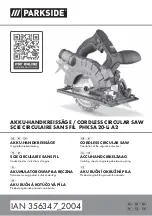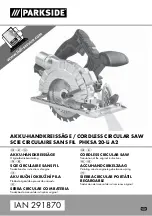
g) Follow all charging instructions and do not charge the battery pack or tool outside the temperature range
specified in the instructions.
Charging improperly or at temperatures outside the specified range may damage the
battery and increase the risk of fire.
6) Service
a) Have your power tool serviced by a qualified repair person using only identical replacement parts.
This will
ensure that the safety of the power tool is maintained.
b) Never service damaged battery packs.
Service of battery packs should only be performed by the manufacturer or
authorized service providers.
Safety Warnings for battery pack
a) Do not dismantle, open or shred cells or battery pack.
b) Do not short-circuit a battery pack. Do not store battery packs haphazardly in a box or drawer where they may
short-circuit each other or be short-circuited by conductive materials.
When battery pack is not in use, keep it
away from other metal objects, like paper clips, coins, keys, nails, screws or other small metal objects, that can
make a connection from one terminal to another. Shorting the battery terminals together may cause burns or a
fire.
c) Do not expose battery pack to heat or fire. Avoid storage in direct sunlight.
d) Do not subject battery pack to mechanical shock.
e) In the event of battery leaking, do not allow the liquid to come into contact with the skin or eyes. If contact has
been made, wash the affected area with copious amounts of water and seek medical advice.
f) Seek medical advice immediately if a cell or battery pack has been swallowed.
g) Keep battery pack clean and dry.
h) Wipe the battery pack terminals with a clean dry cloth if they become dirty.
i) Battery pack needs to be charged before use. Always refer to this instruction and use the correct charging
procedure.
j) Do not maintain battery pack on charge when not in use.
k) After extended periods of storage, it may be necessary to charge and discharge the battery pack several times to
obtain maximum performance.
l) Battery pack gives its best performance when it is operated at normal room temperature
(20 °C ± 5 °C)
.
m) When disposing of battery packs, keep battery packs of different electrochemical systems separate from each
other.
n)
Recharge only with the charger specified by TACKlife. Do not use any charger other than that specifically
provided for use with the equipment.
A charger that is suitable for one type of battery pack may create a risk of
fire when used with another battery pack.
o) Do not use any battery pack which is not designed for use with the equipment.
p) Keep battery pack out of the reach of children.
q) Retain the original product literature for future reference.
r) Remove the battery from the equipment when not in use.
s) Dispose of properly.
t) Do not mix cells of different manufacture, capacity, size or type within a device.













































